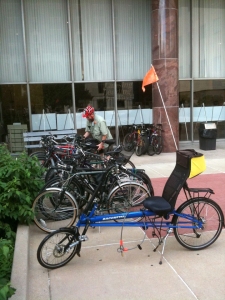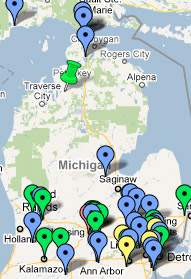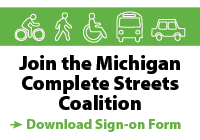You are currently browsing Rory Neuner’s articles.
One of the key reasons to support complete streets policies is for the health benefits of active transportation — streets that safely accommodate walking, biking and transit use give people the option to choose healthier ways of getting around. And boy, could we use more exercise — according to the National Complete Streets Coalition, nearly 32% of adults are obese, and the number of overweight or obese American children nearly tripled between 1980 and 2004. Health experts agree that a big factor is inactivity – 55 percent of the U.S. adult population falls short of recommended activity guidelines.
Now is your chance to tell the federal government how important the connection between health and infrastructure is to communities across the U.S. The U.S. Department of Health and Human Services (HHS) is soliciting comments and feedback on the Healthy People 2020 process. Every 10 years, HHS issues a decade’s worth of national objectives for promoting health and preventing disease. Since 1979, Healthy People has set and monitored national health objectives to meet a broad range of health needs, encourage collaboration, and to guide individuals toward making informed health decisions.
The objectives are quite wide-ranging, but several pertain to active living and bicycle and pedestrian issues. Comments are due on objectives by December 31, 2009 – but it’s very informal and easy to comment. Individuals and organizations alike are submitting a sentence or two on the objectives they care about most.
To comment, go to http://www.healthypeople.gov/hp2020/Comments/default.asp
Yet another Michigan city has recognized the link between infrastructure and livability, and stepped up it’s commitment to safe infrastructure for walking and biking. Yesterday we heard from Traverse City Mayor Chris Bzdok, who wrote to inform us that the City adopted a new infrastructure policy in September — one that includes an emphasis on complete streets. The policy makes an expressed bias in favor of sidewalk and bikeway construction. See more over at http://www.ci.traverse-city.mi.us/Policy/InfrastructureStrategyPolicy.pdf
In addition to this new infrastructure policy, the City will dedicate 10% of its infrastructure budget to sidewalks, bikeways and other people-friendly infrastructure, the highest known percentage commitment of any municipality in the state of Michigan.
Mayor Bzdok’s commitment to these issues is sincere – he can often be seen riding his bicycle to work and to City Hall. Meanwhile, his administration has additional complete streets-related goals for the City, outlined in full at www.planfortc.com.
We could go on about these goals, but this quote says it best:
“[We desire s]treets that serve not only cars, but also bicycles and pedestrians. It means bike lanes, sidewalks, and safe places for people to cross our major roads. It means solving the problems on Division Street. It means re-striping Eighth Street so people can ride their bicycles safely between Boardman and Central neighborhoods. It means installing or improving pedestrian crossings over US-31 at Fourteenth Street, Eleventh Street, Randolph, Grandview Parkway, Oak Street, Hall Street, Garfield, Eighth Street, and Parsons. It means providing safe routes to school.
In part, this is an equity issue. Not everyone has a car, or is in a position to drive. They deserve a way to get around town, too. In part, this is a plan for reducing traffic in our city. If we don’t make it safe and convenient for people to travel on foot or bicycle, how can we ever expect them to get out of their cars? It’s also about being a desirable city. The most sought-after places around the country provide for walking and biking throughout their city limits, and residents and visitors in those cities do just that. It’s time we get with the program.”
Well put, Mayor Bzdok. Thanks for your leadership on these important issues!
Today State Representative Jon Switalski introduced House Resolution 187 to express support for active transportation infrastructure options that promote walking and bicycle usage and reduce childhood obesity. Representative Pam Byrnes also introduced a companion House Concurrent Resolution, HCR 034.
Dubbed the “Complete Streets Resolution”, this piece is the work of a Healthy Kids, Healthy Michigan workgroup, which includes a wide array of advocates working to improve active infrastructure options and reduce childhood obesity. It is the hope of the workgroup that the resolution will help educate lawmakers and citizens about the benefits of active infrastructure. The workgroup also supports the eventual passage of a standalone bill.
Visit the Michigan Legislature website to view the full resolution and see the full list of co-sponsors. And don’t forget to contact your Legislator and urge him or her to support both resolutions.
Proving that we haven’t forgotten about Michigan’s upper half, we here at the Michigan Complete Streets Coalition want to share some good news from the Upper Penninsula’s most populous city.
Marquette residents awoke two weeks ago to find their city a bit more walk- and bike-friendly. On October 29th, road workers completed a resurfacing project on a one-mile portion of Wright Street, which runs east to west on the city’s north end.
Aside from resurfacing, the project also included work to reconfigure Wright Street, taking it from four lanes of traffic down to two lanes and a center turn lane, with room leftover to add four-foot wide bike lanes on either side. Engineers across the country are putting roads like Wright Street on a “road diet”, finding out in the process that their streets become leaner, safer, and more efficient.
Based on their comments, city officials seem hesitant about committing to the reconfiguration as anything more than a temporary experiment. But if the Wright Street experiment is anything like other road diet projects, city officials will soon be singing the praises of fewer crashes and improved safety. In fact, the data shows that using road diets and complete streets planning principles not only makes the our streets safer and more productive, it can also help encourage increases in commercial and residential property values, and can spur new development.
Kudos to Marquette city officials for taking that kind of risk.
Taking a stroll? Ann Arbor is the safest city in Michigan to do it, while Flint is the most dangerous according to a national report released today.
Overall, the number pedestrians killed each year in Michigan is above the national average (12.2% in Michigan, compared with 11.8% nationally). Cities including Lansing, Grand Rapids and Jackson scored favorably, while Detroit, Monroe, and others scored well below the national average. Click here for the complete data on Michigan.
More than 4,500 Americans died last year while walking in the nation’s cities and towns. In Michigan, 253 pedestrian fatalities were recorded in 2007 and 2008.
The report—Dangerous by Design: Solving the Epidemic of Preventable Pedestrian Deaths—was authored by Transportation for America and the Surface Transportation Policy Partnership. It was released in Michigan through the Michigan Environmental Council.
The report shows that communities that invest in safe, complete streets — those that encourage pedestrians, cyclists and motorists to coexist safely — are the safest places to walk. Walk- friendly policies and infrastructure should be a key pillar of policies to encourage revitalization of urban cores throughout the state.
Unfortunately, only a trickle of transportation funding is used to address pedestrian safety. Pedestrian deaths account for 12 percent of all traffic deaths, yet only 1.5 percent of funds available in the current federal transportation bill are directed toward pedestrian safety.

The bike rack was overflowing in front of City Hall as over 60 Complete Streets supporters came out to testify before City Council on August 10, 2009.
The Lansing City Council voted unanimously on Monday night to adopt a Complete Streets and Non-Motorized Plan Ordinance. This is a big victory for cyclists and pedestrians in Lansing, and for the Complete Streets movement in Michigan. Lansing becomes the first municipality in the State of Michigan to pass a Complete Streets ordinance, and joins a host of other communities across the state in committing to develop a non-motorized plan.
The effort to pass the ordinance was organized by the Walk and Bike Lansing! Task Force. Led by the Mid-Michigan Environmental Action Council, the task force is composed of a diverse group of community and state partners, including LMB and MEC. The initiative came to City Council by way of a signature drive, through which volunteers collected over 4,520 signatures of registered Lansing voters. Another 90 letters of support and 60 public comments at a recent Council meeting didn’t hurt, either.
There’s more information on this milestone at the Walk and Bike Lansing! website, but in summary, this ordinance:
- Requires the City of Lansing to adopt a Non- Motorized Network Plan.
- The Non-Motorized Network Plan would include, at a minimum, accommodations for accessibility, sidewalks, curb ramps and cuts, trails and pathways, signage, and bike lanes, and shall incorporate the principles of Complete Streets and maximize walkable and bikeable streets within the City.
- To the extent financially feasible, future construction or reconstruction of City rights-of- way or any parts thereof shall be in conformity with the Non-Motorized Network Plan.
- Sets a goal to adequately funding walk- and bike-friendly infrastructure. (The City of Lansing currently spends 2% to 3% for non-motorized facilities. The ordinance sets a goal of 5% for future budget years).
- Require an update of the Non-Motorized Network Plan every five years from the date of adoption.
Congratulations, Lansing! Here’s to hoping other Michigan communities and road agencies follow your lead!















